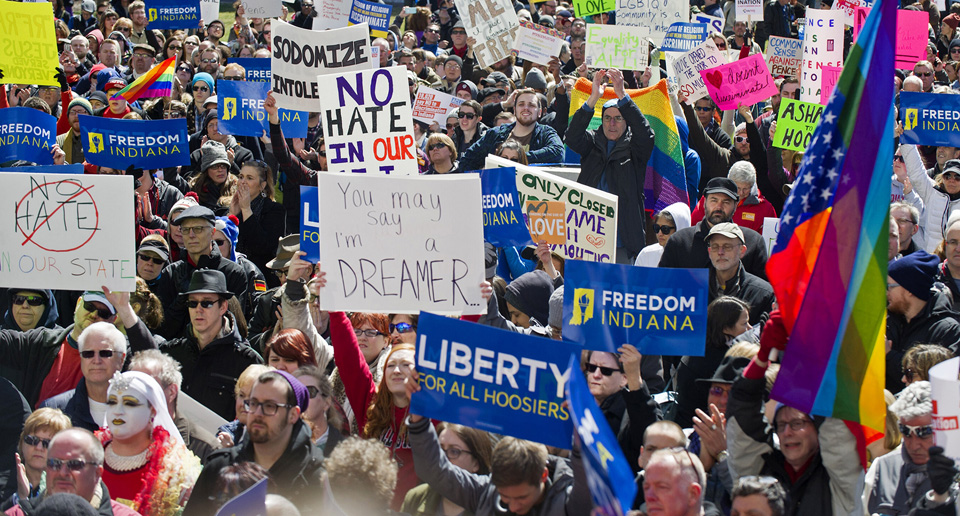
INDIANAPOLIS — Mike Pence was here in Indiana beating the bushes last Sunday, though not for his running mate Donald Trump. He was campaigning for Eric Holcomb, who Pence had handpicked to succeed him as governor.
Polls show Holcomb’s rival for the governorship, Democratic candidate John Gregg, is in the lead as we enter the last week of the campaign.
Is helping Holcomb catch up to Gregg more important to Pence than working to elect his running mate Donald Trump? Apparently so.
When Pence agreed to be Trump’s running mate, many observers said he had done so because he could not win for re-election as governor next year. If Holcomb losses, it would be evidence that the observers were probably correct.
While Trump is projected to carry Indiana, his average lead (6 percent) in the polls is much lower than expected. Pence taking time out from battleground states to shore up Republicans in Indiana shows that Trump is worried about the usually solid red Hoosier state.
In another surprise, Evan Bayh, a former Indiana governor and senator, entered the race for Senate to replace primary winner Baron Hill after it became clear that the Democratic Party could not support Hill’s race against Todd Young to fill the seat of retiring Senator Dan Coates.
Bayh, a conservative Democrat, brought with him a campaign war chest of over $9 million.
Bayh immediately became the target of millions of dollars in ads attacking him for making a fortune from Wall Street and big banks. Paid for by the Chamber of Commerce (for whom Bayh was working as recently as last June) and the Koch brothers, these ads, ironic though they may be considering where they come from, have cut into Bayh’s support. The race is now considered a toss-up.
The 2016 election is also bringing into question the Republican hold on the Congressional delegation. After the severe gerrymandering of House Districts in 2011, the Indiana delegation went from five Democrats and four Republicans in 2010 to two Democrats and seven Republicans this year.
Democrats might win two House seats
Despite that, there are two Democrats challenging Republicans in seats that had been considered safely in GOP hands this election.
Lynn Coleman of South Bend is challenging Jackie Walorskie for the 2nd District seat. Coleman, who is African American, is a retired police officer and city administrator. He has a long record of respected service in the South Bend community. The District was redrawn so that it would be dominated by rural counties. However, Walorski’s lack luster record and Coleman’s progressive history and platform have made the race a real contest.
Furthermore, in southwestern Indiana’s 9th District, Shelli Yoder, a professor at Indiana University and a Monroe County councilman, is challenging Republican millionaire Trey Hollingsworth for the seat vacated by Todd Young.
Yoder was given little chance of winning because of the Republican gerrymandering, but the most recent polls show her tied with Hollingsworth, who moved to Indiana last year to run for this seat
Hollingsworth has attacked Yoder for being willing to reduce military spending in order to increase infrastructure investment. She has been endorsed by the AFL-CIO and the NEA. She has championed a jobs program focused on the need for infrastructure in a state notorious for neglect of its bridges and roads. She has also pledged to find funds to increase reliable broadband service in rural Indiana, especially for students.
Pence forced to back down
In the governor’s race, Gregg, who was narrowly defeated by Pence four years ago, is doing surprisingly well, according to local experts. His campaign focused on the low wages of Indiana workers. (The state ranks 31st in the nation for wages.) And he is pointing out the shambles that was made in Indiana’s public schools by the Republican-led legislature, Governor Pence and former Governor Daniels.
Gregg has pledged to raise the minimum wage in the state, currently at $7.25. His primary support comes from the AFL-CIO which helped him launch his campaign with major contributions from several unions.
Education is a primary issue for Gregg, who is a former university president. He has challenged the Republican’s drive to privatize Indiana public schools by shifting tax dollars to charter, private and even religious schools. This maneuver proved to be unpopular with Hoosiers.
The fight back began in 2012 when the state superintendent of education, a Republican, was defeated for re-election. Teachers and their supporters worked to elect Glenda Ritz, a former teacher.
For the past four years Pence has tried to undermine Ritz’s authority and sabotage her efforts to reverse course on school privatization policies. For example, Pence supported the legislature in shifting more tax money to private schools.
Indiana has done more to privatize public schools than any other state.
Another factor driving support for Gregg is the public’s rejection of Pence and the legislature to put so-called “Christian values” in state law. Pence, who was one of the leaders in Congress who tried to shut the government down in order to defund Planned Parenthood, encouraged the legislature to pass the Religious Freedom Restoration Act last year. That law made it legal for individuals to discriminate against gay people on religious grounds.
Pence was then immediately forced to back down and “fix the RFRA” by the state’s major corporations, but there is still no state wide civil rights protection for members of the LGBTQ community.
However, cities can adopt laws mandating such protection, and they are.
This year the legislature passed, and Pence signed, another law continuing the Republicans’ attack on women’s rights by severely regulating abortions and requiring women to bury any fetus that does not come to term.
That law is under appeal, but the requirement that women must pay for the burial of the result of a miscarriage, let alone an abortion, has outraged many.
This is one of the reasons why Pence chose to run for VP rather than stand for re-election.
Gregg has rejected such “divisive social issues” and has built his campaign around proposals to create jobs and improve education.










